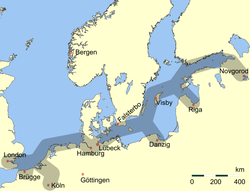There Hanseatic League it was an alliance between some cities that in the late Middle Ages and until the beginning of the modern era maintained the monopoly of trade over much of theNorthern Europe and the Baltic Sea. Its foundation is traced back to the twelfth century.
To know

The main city of the Hanseatic League was Lübeck. Its position on the Baltic gave it access to trade with the Scandinavia and the Russia, bringing it into direct competition with the Scandinavians who had previously controlled much of the Baltic trade routes. Allied cities were able to take control of much of the salt fish trade. Other similar alliances formed throughout the Holy Roman Empire. Over time, the network of alliances grew to include more than 100 cities. German settlers built numerous Hanseatic cities on the Baltic, such as Reval (Tallinn), Line is Dorpat (Tartu). Some of these are still full of buildings from the era of the League. Livonia (today's Estonia is Latvia) had its Hanseatic parliament (diet) and all its major cities were members of the League. Eventually, the capital of Hansa was moved to Gdansk, which was the main port for Polish (at the time German) merchandise transported along the Vistula. Other important cities, members of the League, were Thorn (today's Toruń), Elbing, Königsberg is Krakow.
The League was heterogeneous, but its members shared some characteristic traits. First, most Hanseatic cities were founded either as independent cities, or gained independence through the collective bargaining power of the League. The League also exercised its power abroad: between 1368 and 1370. The exclusive trade routes were often obtained at a high price. In many foreign cities, Hansa merchants were confined to certain trading areas and their trading posts. The very existence of the League and its privileges and monopolies created economic and social tensions which often turned into a form of rivalry between the members of the League. By the end of the 16th century, the League imploded and was unable to manage the infighting. The definitive collapse came with the Thirty Years War, which sanctioned Swedish dominance in the Baltic. At the last diet of the League, in 1669, only three cities showed up: Lübeck, Hamburg is Bremen. In the 20th century, German cities continued to boast their important Hanseatic origin. Lübeck, like Bremen, was a "Free Hanseatic city".
Members
These were some of the cities of the Hanseatic League:
Baltic countries
- 1 Tallinn - It became part of the Hanseatic League in 1285. It is included among the World Heritage of Humanity.
- 2 Line —
Finland
- 3 Turku - While not formally a member of the "original" League, he had strong commercial ties and is a member of the "new" League of the 20th and 21st centuries.
Germany
- 4 Lübeck - The primus inter pares for most of the League's existence, it only lost its political autonomy in 1930, when it was stripped of that status by the Nazis. Heavily bombed during the war, it was rebuilt more or less in the original style and boasts immensely its heritage as a Hanseatic city.
- 5 Hamburg - An important member, even though he was west of the major players (Baltic) and as such his "golden age" began only after the end of the League.
- 6 Bremen - A member of the League who keeps his status in Germany.
- 7 Rostock - One of the League members showing his former membership on his license plate (HRO for Hansestadt Rostock)
- 8 Stralsund —
- 9 Wismar —
- 10 Greifswald —
Norway
- 11 Bergen —
Poland
- 12 Gdansk —
Sweden
- 13 Stockholm - While not a member of the Hanseatic League, the Hanseatic merchants had a lot of influence in Stockholm, until the Swedish Empire came to dominate the Baltic Sea during the 17th century.
- 14 Visby - It is inserted between World Heritage of Humanity.
Events of the Hanseatic League today


Most of the cities that have a right of Hanseatic inheritance are now members of the "new Hanseatic League" and as such are holders of modern "Hanseatic days". The first was held in 1980 a Zwolle in Netherlands and are usually held in the summer months (the main holiday season in this area), with many League themed events, as well as representative of (almost) all other Hanseatic cities.
The next events until 2030 are scheduled to:
- 2021 – Line, Latvia
- 2022 – Neuss, Germany
- 2023 – Toruń, Poland
- 2024 – Gdańsk, Poland
- 2025 – Visby, Sweden
- 2026 – Stargard Szczeciński, Poland
- 2027 – Braunschweig, Germany
- 2028 – Stralsund, Germany
- 2029 – Wismar, Germany
- 2030 – Zwolle, Holland
Museums
- 15 European Hansemuseum, An der Untertrave 1, Lübeck, Germany. Opened in 2015, this is perhaps the best of the Hanseatic League's historical museums as it offers an in-depth look into Lübeck's more than 800-year history and how it shaped the League.
Museums in several other cities often also have a focus on the history of the Hanseatic city, if and where this was important.
Other projects
 Wikipedia contains an entry concerning Hanseatic League
Wikipedia contains an entry concerning Hanseatic League Commons contains images or other files on Hanseatic League
Commons contains images or other files on Hanseatic League
